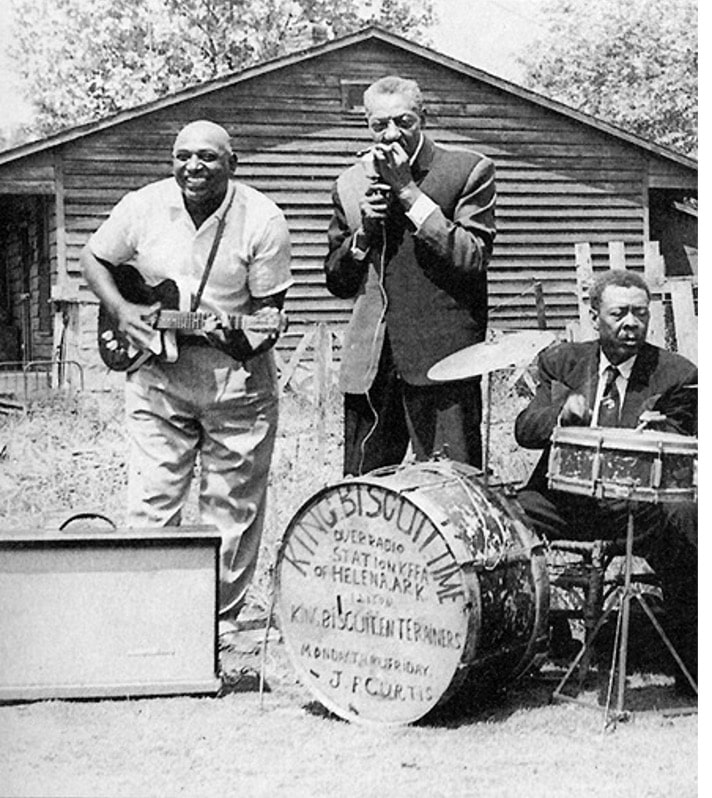
Culinary Roots - The Joy Of Eating (Part 2)
The Joy of Eating: How I became a foodie
My musical roots intertwined with my culinary roots: Blues Harmonica God Sonny Boy Williamson was based in Helena, Arkansas. He died in 1965. He played on the radio every Saturday at 1pm on KFFA. Sponsored by King Biscuit Time, I would listen to him over my grandmother’s old timey radio that she kept in the kitchen and always had set to the Jesus station. She liked to listen to gospel music while she cooked or baked. She would get mad when I would forget to rotate the dial back to her station.
My grandmother, Rutha McAbee, was born in 1898 in Paducah, Kentucky. Her family emigrated to Arkansas when she was a child. From ages 14 to 30, Rutha cooked for cotton pickers working in the fields that surrounded her parents’ sharecropper home. Fieldhands ate two breakfasts, one at daybreak and a second at 11 am. Field cooks had to get the “most-est from the least-est,” as plantation and cottonfield owners wanted to feed the most-est number of fieldhands for the least-est amount of money. All field cooks in those times faced the same challenge: who can create the best tasting food using the cheapest of ingredients?
The only meat they had to work with were throwaway cuts of pork. The overlords kept all the beef for themselves and took the best cuts of pork before turning over the tough, unwanted pig leftovers, the offal and carcass meat, to fieldhand cooks. Young Rutha was schooled by women that had lived through the Civil War and knew how to make tasty the nasty bits. They repurposed uneatable pig parts. These innovative field cooks broke down uneatable meat using the low and slow methods that birthed southern barbeque.
As in any other occupation, some are better than others. My grandmother was in high demand for a decade and only stopped cooking when she married the town barber, Will Moore. They had several children in quick succession. They owned an acre plot on a gravel road a mile outside tiny Rector. Will cut hair while Rutha raised children, chickens, geese, turkey, dogs, and cats. She tended a large truck garden, canned fruit and vegetables, and bartered sewing for pork. When Will died, Rutha carried on. Her hodgepodge home did not get an indoor bathroom until 1965. Before that, it was an outhouse in the chicken yard in February with a flashlight. Hope you don’t get a spider bite.
She loved to cook for company. You would wake up to the smell of baking biscuits and ultra-strong “River Coffee.” My favorite breakfast was a big mug of hair-raising black coffee while reading The Clay County Democrat. This was followed by four, fresh from the oven, fluffy biscuits, crispy brown exterior, steaming pillow interiors. I would break them in half and douse with butter from nearby Thompson’s Dairy.
After allowing the butter to melt into the biscuits, I would drench the buttered biscuits with however much of her, ‘perfected over decades’ white pepper gravy was in the gravy bowl, knowing there was always more. Her white pepper gravy over made from scratch butter-drenched biscuits represented to me the high-water mark of hardcore southern hillbilly culinary expertise: take flour, water and some bacon drippings and create something so incredibly cheap and so incredibly delicious that it kept man and beast alive through the bleakest, hardest of times for the least amount of money.
Rutha would shuffle in with four perfectly cooked sunny-side-up eggs, deep orange yolks, along with crispy strips of thick bacon or assertive pork sausage patties. This was just the first of three serious meals, always kicked off with ethereal biscuits and gravy. A bacon grease sieve sat on her tiny, four-burner porcelain propane stove, this to recycle the wonderful organic pork lipid. Her little white stove had a small oven from which sprang her legendary lard-crust fruit pies.
Depending on the season, she served whatever vegetables were fresh plucked from her truck garden. I loved green beans and carrots broken down slow and low with thick slices of fatback. Winter fare included ham hocks with white beans. I became addicted to rich spinach topped with butter and salt. Watermelon centers were my favorite fruit. While my family were big on okra, I did not like it one bit. This was farm-to-table eating before the phrase had been invented. No one ate salads. I never saw a salad made or eaten.
The main proteins were chicken (always fried,) and pork, mostly bacon and sausage, occasionally sublime massive pork chops with acidic sauerkraut and cold applause (rife with apple chunks.) We ate quite a bit of monstrous Mississippi river catfish, always cut like a steak, dredged in flour or cornmeal, and deep fried. My favorite taste treat were cornmeal hushpuppies, fried crispy in the catfish oil.
She was a master baker and created wonderful fruit pies. In the cold months she would select from her ample collection of canned fruits and vegetables. She kept frozen proteins in a giant freezer that sat in the guest bedroom. When guests visited my grandmother would walk out to the chicken yard, open the gate and quietly, nonchalantly, pick up a three-foot section of rebar with a hook on one end.
Grasping the rebar in her right hand she would casually stroll through the chicken yard, looking, looking, looking, until she came upon a bird to her liking. With a lightning-fast movement that only comes with decades of practice (and in defiance of her age,) she would hook a webbed foot, pull the rebar towards her, grab the confused chicken, wring it’s head off and toss the chicken head over the outhouse and into the dark woods in one seamless motion.
She would drain and pluck the bird. These chickens were free-range, organic, fed on human scraps and supplemented by bountiful bugs and crawlies, that inhabited the semi-swampy patch of land that was the chicken yard. I never knew her to roast a chicken. Her fried chicken was seasoned, battered in King Biscuit flour, fried in bacon grease or lard to produce super crispy skin with moist interior. As a 15-year-old, I easily ate an entire fried chicken she had made for company that canceled at the last minute.
Rutha was a primal woman living a primal life and living it alone. Someone once asked chef God Jacque Pepin, if he could choose, what would be his last meal? He got wistful and teary as he specified his mother’s perfectly roasted free-range chicken, a chicken from their chicken yard on the family farm. He added that the meal should include small red potatoes, carrots, and onions, sat in the bottom of the roaster pan. I would second Jacques emotion, substituting fried chicken and biscuits and white pepper gravy. I too knew that ancient primal taste Jacque remembered and craved; I too have Jacques’ selfsame retrospective longing.
About the Author - Marty Gallagher
As an athlete Marty Gallagher is a national and world champion in Olympic lifting and powerlifting. He was a world champion team coach in 1991 and coached Black's Gym to five national team titles. He's also coached some of the strongest men on the planet including Kirk Karwoski when he completed his world record 1,003 lb. squat. Today he teaches the US Secret Service and Tier 1 Spec Ops on how to maximize their strength in minimal time. As a writer since 1978 he’s written for Powerlifting USA, Milo, Flex Magazine, Muscle & Fitness, Prime Fitness, Washington Post, Dragon Door and now IRON COMPANY. He’s also the author of multiple books including Purposeful Primitive, Strong Medicine, Ed Coan’s book “Coan, The Man, the Myth, the Method" and numerous others. Read the Marty Gallagher Biography for a more in depth look at his credentials as an athlete, coach and writer.



